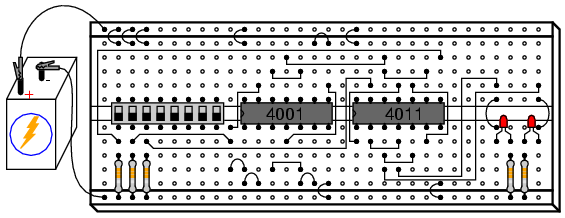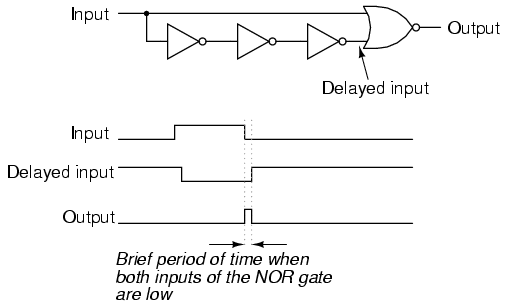NAND gate S-R flip-flop
PARTS AND MATERIALS
-
4011 quad NAND gate (Radio Shack catalog #
276-2411)
-
4001 quad NOR gate (Radio Shack catalog #
276-2401)
-
Eight-position DIP switch (Radio Shack
catalog # 275-1301)
-
Ten-segment bargraph LED (Radio Shack
catalog # 276-081)
-
One 6 volt battery
-
Three 10 kΩ resistors
-
Two 470 Ω resistors
Caution! The 4011 IC is CMOS, and
therefore sensitive to static electricity!
Although the parts list calls for a
ten-segment LED unit, the illustration shows two individual
LEDs being used instead. This is due to lack of room on my
breadboard to mount the switch assembly, two integrated
circuits, and the bargraph. If you have room on your
breadboard, feel free to use the bargraph as called for in
the parts list, and as shown in prior latch circuits.
CROSS-REFERENCES
Lessons In Electric Circuits, Volume
4, chapter 3: "Logic Gates"
Lessons In Electric Circuits, Volume
4, chapter 10: "Multivibrators"
LEARNING OBJECTIVES
-
The difference between a gated latch and a
flip-flop
-
How to build a "pulse detector" circuit
-
Learn the effects of switch contact
"bounce" on digital circuits
SCHEMATIC DIAGRAM

ILLUSTRATION

INSTRUCTIONS
The only difference between a gated
(or enabled) latch and a flip-flop is that a
flip-flop is enabled only on the rising or falling edge
of a "clock" signal, rather than for the entire duration of
a "high" enable signal. Converting an enabled latch into a
flip-flop simply requires that a "pulse detector" circuit be
added to the Enable input, so that the edge of a clock pulse
generates a brief "high" Enable pulse:

The single NOR gate and three inverter gates
create this effect by exploiting the propagation delay time
of multiple, cascaded gates. In this experiment, I use three
NOR gates with paralleled inputs to create three inverters,
thus using all four NOR gates of a 4001 integrated circuit:

Normally, when using a NOR gate as an
inverter, one input would be grounded while the other acts
as the inverter input, to minimize input capacitance and
increase speed. Here, however, slow response is desired,
and so I parallel the NOR inputs to make inverters rather
than use the more conventional method.
Please note that this particular pulse
detector circuit produces a "high" output pulse at every
falling edge of the clock (input) signal. This means
that the flip-flop circuit should be responsive to the Set
and Reset input states only when the middle switch is moved
from "on" to "off," not from "off" to "on."
When you build this circuit, though, you may
discover that the outputs respond to Set and Reset input
signals during both transitions of the Clock input,
not just when it is switched from a "high" state to a "low"
state. The reason for this is contact bounce: the
effect of a mechanical switch rapidly making-and-breaking
when its contacts are first closed, due to the elastic
collision of the metal contact pads. Instead of the Clock
switch producing a single, clean low-to-high signal
transition when closed, there will most likely be several
low-high-low "cycles" as the contact pads "bounce" upon
off-to-on actuation. The first high-to-low transition caused
by bouncing will trigger the pulse detector circuit,
enabling the S-R latch for that moment in time, making it
responsive to the Set and Reset inputs.
Ideally, of course, switches are perfect and
bounce-free. In the real world, though, contact bounce is a
very common problem for digital gate circuits operated by
switch inputs, and must be understood well if it is to be
overcome.
|